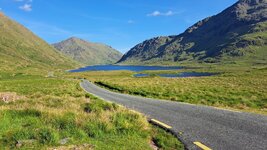22 Days in Ireland, arriving in Belfast, departing Rosslaire and trying to see the entirety of the Wild Atlantic Way along with other coastal points of Interest was challenging, ultimately tiring but rewarding. It's definitely something worth doing. Amongst other things I'd visited the Belfast Titanic Experience, Giant's Causeway, Malin Head, Slieve League, Ceide Fields, Cliffs of Moher, Slea Head, Mizen Head, and driven round most of the north east, north, west and southern coastline including the Northern Ireland Causeway Route, Donegal, County Mayo, Connemara, Dingle, Beara Loop.

According to the trip meter I drove some 2,190 miles taking nearly 79 hours at an average speed of only 27mph. Given I had a couple of rest days, that meant some days I drove for more than 6 hours, in between pauses to look at something. The low speeds reflect that most of the coastal roads are windy, bumpy, up and down single track. Even the bigger roads, the R roads were very narrow. Only in the south did the N roads allow 50+ mph speeds to be consistently possible (yes I know they do stuff in kph), yet even those would have a chicane of bends thrown in for good measure. Dual carriageways were a luxury.

My tour was in a Ducato based PVC. That is comfortably over 2m wide, with more for the mirrors. There were some mountainous passes where that would be too wide. It was not infrequent to need to pull over on many roads that should be considered two way, to allow something else to get past. My van is short, at 6m even with the cycle rack. Length wasn't really an issue, apart from a couple of dead end turn rounds, so I think 7m plus length would be OK. But many coachbuilt or A class wider motorhomes will find the width awkward on the local windy single track roads, which can have a hairpin bend with inconvenient stone wall. The greatest issue for the van was height as increasingly there are barriers on car parks, even some of the signposted Wild Atlantic Way beach viewpoints. The height barriers were more prominent in the south. Oh do watch out for the random sheepdog that will jump out without warning from an unguarded farmer's drive which occurred on too many occasions.

Is it best to do the Wild Atlantic Way clockwise or anticlockwise? Some guides say clockwise as you drive on the left and so are closer to the sea, but then so many roads are narrow you won't miss much. A couple of routes such as Slea Head are signed to encourage everyone driving the same way. But driving by myself anticlockwise offered a greater chance of the briefest pauses to stick the camera out of the driver's window for that cliff spot.

I've covered the narrow windy roads, and perhaps I was fortunate with traffic being very light. There were of course local tractors, but you could go 5 minutes or more without another vehicle. Town centres were often busy, and I passed those by being often difficult to spot a likely parking space. But everyone suggested that July and August would be different as the Irish school holidays kicked in. Certainly campsites were bracing themselves to be much fuller and many indicated they would have no space. A problem for touring when you weren't quite sure where you'd be wanting to stop. Park4Night was my friend for overnight stops but also whether there would be amenity such as water taps. I also found the Total Motorhome Ireland map (a €5 yearly subscription), good for hinting at potential pub stops and motorhome specific sites.

Excepting campsites, I found very few places to legitimately dispose of black and grey waste, or even take on fresh water. Yes there were public toilet blocks, but those aren't really intended for that purpose. Of taps that exist, it's not clear how many were drinking quality. There are plenty of bottle banks for recycling, but other rubbish it was clear they didn't want "household" stuff in the few street bins that existed. Bottom line booking onto a motorhome park or campsite every 3rd or 4th day made life easy. As I didn't need hook up I think the most extravagant cost was under €20 a night, even when paying extra for refuse.

Diesel proved around 5p a litre cheaper on average than UK, even after exchange rates. Obviously the more remote an area, the more pricey it might be. Use a debit type card that doesn't have any abroad fees and just charges the standard mastercard / visa exchange rate. A majority of shops, bars etc will accept plastic, only the smallest businesses need cash.
Generally the locals are all very friendly, I only really had the one exception. Do be prepared if in a bar that the B word may arise. Monday and Tuesdays can often be very quiet in most villages, even towns, with a lot of stuff closed. Whether something was open daytime or evening for food would be variable, and often they would do food only Thursday to Sunday, clearly being impacted by expected demand and staffing. A lot of the small high streets have definitely suffered with a lot of closed premises. If food was being served in evenings, typically you needed to be ordering by 7pm. Prices were infinitely variable, but generally compare a pint in the pub to that in the South East of England and dining costs were definitely rising.

I was very fortunate with the weather. I've visited the West Coast in September and it was a far less pleasant experience. In June it was often warm, if not hot often needing sun protection. For a country with high rainfall that was a surprise and I only effectively had problems with poor visibility and rain on a couple of days. But the coastline can also be a very windy place, affecting choice of stop overs at headlands.

For me, the more interesting areas were when the country became rugged and remote. It was supposed to be Wild Atlantic, so more populated areas were less attractive. Donegal, West County Mayo, Connemara, the Dingle and Beara Peninsulas all had features of interest and Northern Ireland's Causeway Coastal route was a pleasant surprise too. I was perhaps less enamoured with the more tourist focused areas such as The Cliffs of Moher and The Ring of Kerry. The information notice boards at points of interest were interesting, albeit a couple repetitive on matters. Some of the exhibition and visitor centres appeared excellent value, for example Ceide Fields and the Slieve League.

If I were to revisit I would concentrate on those more remote areas, there were multiple viewpoints, headlands that I missed out, as well as some specific visitor centres that dealt with matters such as the Blasket Islands and the Famine. There are also many stone rings, forts and other ancient monuments scattered around. I would look a little more inland as there were signs of many mountainous parts that would be of interest. Rather than trying to move on most days it might be easier to base for 2 or 3 days at a time from a site and have the opportunity to explore by good bike (there are plenty of cyclists touring). Planning ahead would offer opportunity to get small day ferries to the little islands. So ultimately whilst doing the entire route was worthwhile a greater focus on part of the country would be less challenging and equally rewarding.

Oh and Guinness is definitely much better in Ireland.

According to the trip meter I drove some 2,190 miles taking nearly 79 hours at an average speed of only 27mph. Given I had a couple of rest days, that meant some days I drove for more than 6 hours, in between pauses to look at something. The low speeds reflect that most of the coastal roads are windy, bumpy, up and down single track. Even the bigger roads, the R roads were very narrow. Only in the south did the N roads allow 50+ mph speeds to be consistently possible (yes I know they do stuff in kph), yet even those would have a chicane of bends thrown in for good measure. Dual carriageways were a luxury.
My tour was in a Ducato based PVC. That is comfortably over 2m wide, with more for the mirrors. There were some mountainous passes where that would be too wide. It was not infrequent to need to pull over on many roads that should be considered two way, to allow something else to get past. My van is short, at 6m even with the cycle rack. Length wasn't really an issue, apart from a couple of dead end turn rounds, so I think 7m plus length would be OK. But many coachbuilt or A class wider motorhomes will find the width awkward on the local windy single track roads, which can have a hairpin bend with inconvenient stone wall. The greatest issue for the van was height as increasingly there are barriers on car parks, even some of the signposted Wild Atlantic Way beach viewpoints. The height barriers were more prominent in the south. Oh do watch out for the random sheepdog that will jump out without warning from an unguarded farmer's drive which occurred on too many occasions.
Is it best to do the Wild Atlantic Way clockwise or anticlockwise? Some guides say clockwise as you drive on the left and so are closer to the sea, but then so many roads are narrow you won't miss much. A couple of routes such as Slea Head are signed to encourage everyone driving the same way. But driving by myself anticlockwise offered a greater chance of the briefest pauses to stick the camera out of the driver's window for that cliff spot.
I've covered the narrow windy roads, and perhaps I was fortunate with traffic being very light. There were of course local tractors, but you could go 5 minutes or more without another vehicle. Town centres were often busy, and I passed those by being often difficult to spot a likely parking space. But everyone suggested that July and August would be different as the Irish school holidays kicked in. Certainly campsites were bracing themselves to be much fuller and many indicated they would have no space. A problem for touring when you weren't quite sure where you'd be wanting to stop. Park4Night was my friend for overnight stops but also whether there would be amenity such as water taps. I also found the Total Motorhome Ireland map (a €5 yearly subscription), good for hinting at potential pub stops and motorhome specific sites.
Excepting campsites, I found very few places to legitimately dispose of black and grey waste, or even take on fresh water. Yes there were public toilet blocks, but those aren't really intended for that purpose. Of taps that exist, it's not clear how many were drinking quality. There are plenty of bottle banks for recycling, but other rubbish it was clear they didn't want "household" stuff in the few street bins that existed. Bottom line booking onto a motorhome park or campsite every 3rd or 4th day made life easy. As I didn't need hook up I think the most extravagant cost was under €20 a night, even when paying extra for refuse.
Diesel proved around 5p a litre cheaper on average than UK, even after exchange rates. Obviously the more remote an area, the more pricey it might be. Use a debit type card that doesn't have any abroad fees and just charges the standard mastercard / visa exchange rate. A majority of shops, bars etc will accept plastic, only the smallest businesses need cash.
Generally the locals are all very friendly, I only really had the one exception. Do be prepared if in a bar that the B word may arise. Monday and Tuesdays can often be very quiet in most villages, even towns, with a lot of stuff closed. Whether something was open daytime or evening for food would be variable, and often they would do food only Thursday to Sunday, clearly being impacted by expected demand and staffing. A lot of the small high streets have definitely suffered with a lot of closed premises. If food was being served in evenings, typically you needed to be ordering by 7pm. Prices were infinitely variable, but generally compare a pint in the pub to that in the South East of England and dining costs were definitely rising.
I was very fortunate with the weather. I've visited the West Coast in September and it was a far less pleasant experience. In June it was often warm, if not hot often needing sun protection. For a country with high rainfall that was a surprise and I only effectively had problems with poor visibility and rain on a couple of days. But the coastline can also be a very windy place, affecting choice of stop overs at headlands.
For me, the more interesting areas were when the country became rugged and remote. It was supposed to be Wild Atlantic, so more populated areas were less attractive. Donegal, West County Mayo, Connemara, the Dingle and Beara Peninsulas all had features of interest and Northern Ireland's Causeway Coastal route was a pleasant surprise too. I was perhaps less enamoured with the more tourist focused areas such as The Cliffs of Moher and The Ring of Kerry. The information notice boards at points of interest were interesting, albeit a couple repetitive on matters. Some of the exhibition and visitor centres appeared excellent value, for example Ceide Fields and the Slieve League.
If I were to revisit I would concentrate on those more remote areas, there were multiple viewpoints, headlands that I missed out, as well as some specific visitor centres that dealt with matters such as the Blasket Islands and the Famine. There are also many stone rings, forts and other ancient monuments scattered around. I would look a little more inland as there were signs of many mountainous parts that would be of interest. Rather than trying to move on most days it might be easier to base for 2 or 3 days at a time from a site and have the opportunity to explore by good bike (there are plenty of cyclists touring). Planning ahead would offer opportunity to get small day ferries to the little islands. So ultimately whilst doing the entire route was worthwhile a greater focus on part of the country would be less challenging and equally rewarding.
Oh and Guinness is definitely much better in Ireland.







